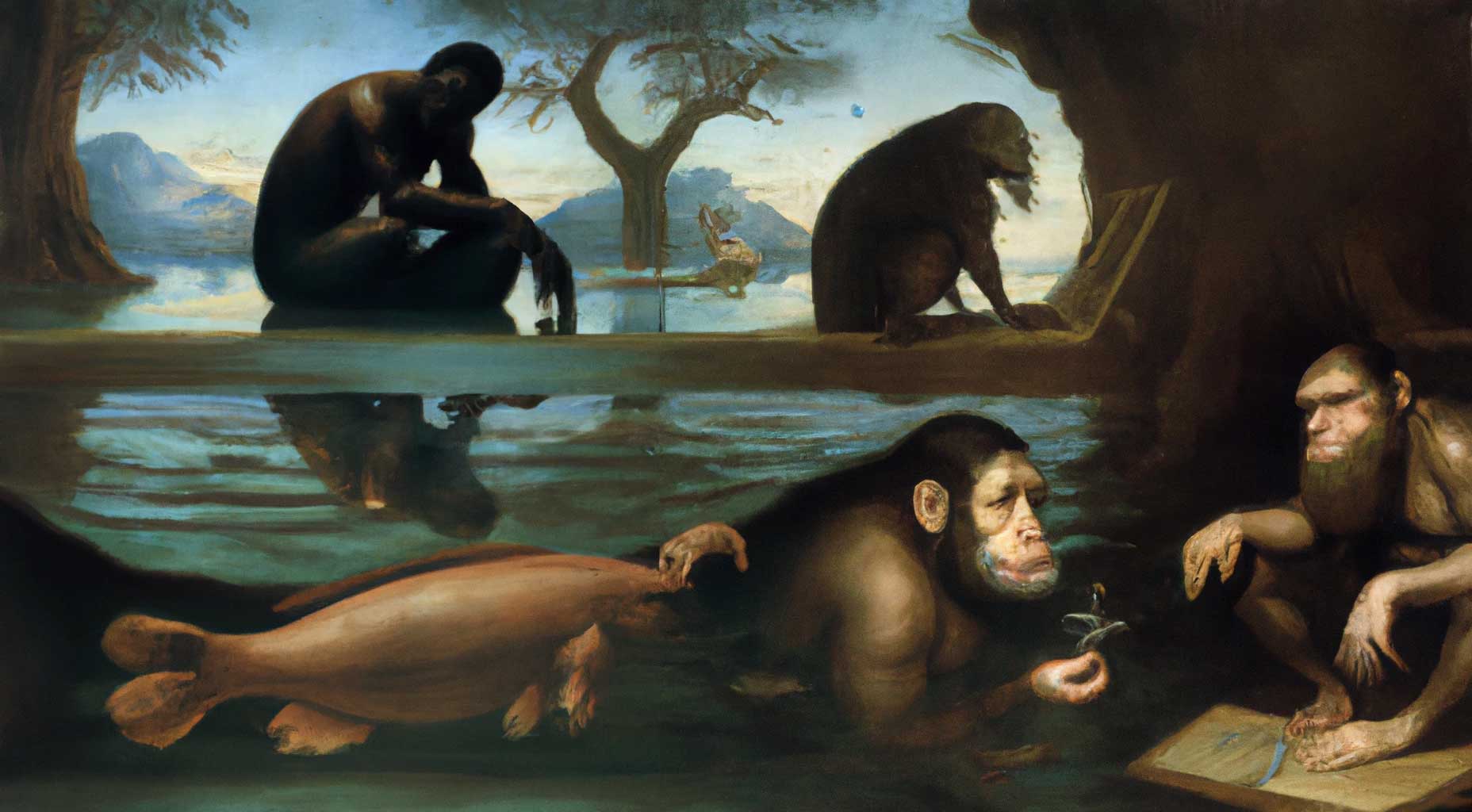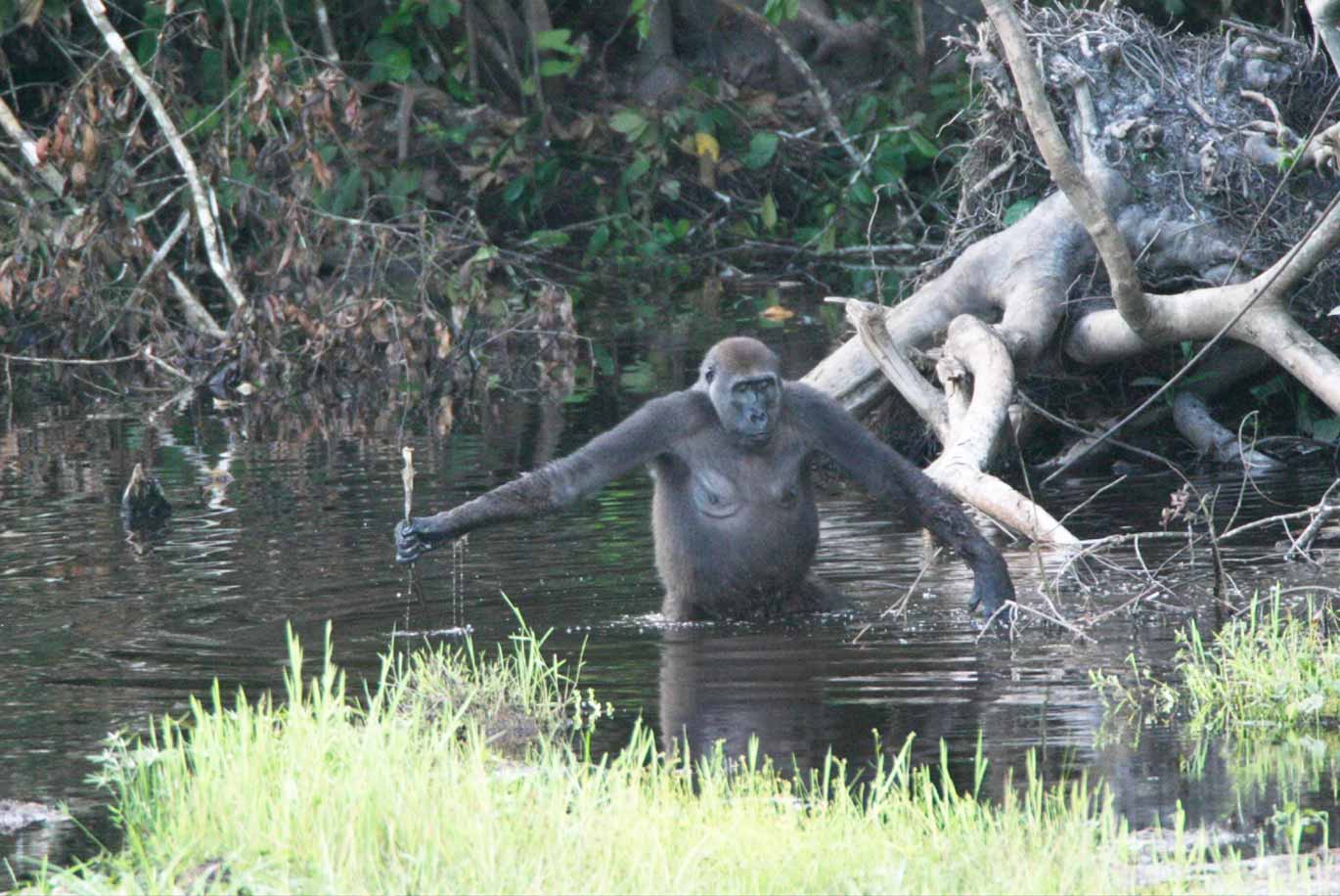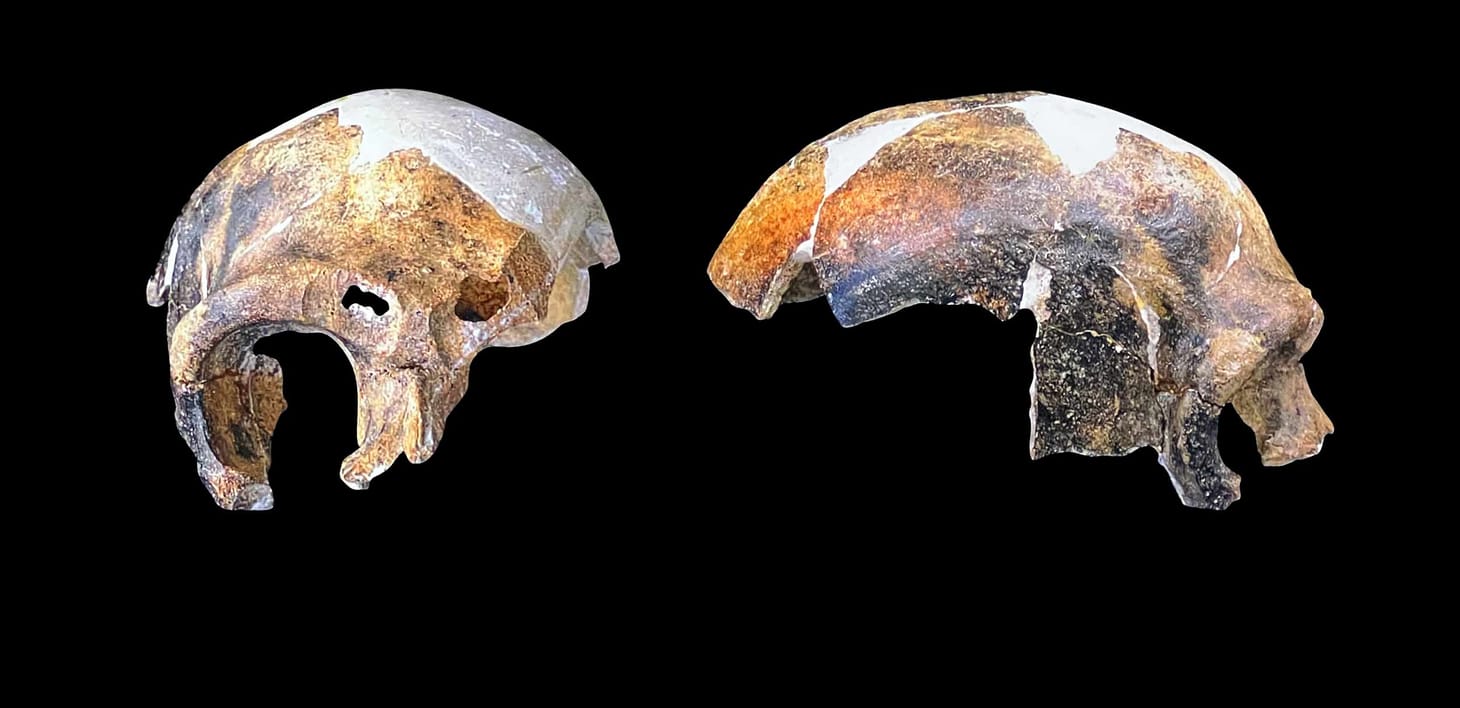Why anthropologists rejected the aquatic ape theory
Human ancestors did not evolve in an aquatic environment. But they did make use of coastal and shoreline resources where they were abundant.

I started using the internet in 1990, when text-based Usenet newsgroups were the social media of the day. In those days, groups like talk.origins and sci.anthropology.paleo brought together people with very different perspectives—and too much time on their hands—who wanted to debate ideas about human origins and evolution.
Anyone who followed these newsgroups saw a hearty share of discussion about an idea known as the aquatic ape theory. According to this idea, humans evolved from apes that lived in or around bodies of water. The theory tried to tie together many human anatomical traits as adaptations to an ancient life foraging on shorelines and in the water.
But boosters of this idea tended to overreach. Some of them asserted that humans share unique similarities with aquatic mammals like seals and dolphins, and these claims turned out to be overstated or false. The most vocal advocates of the idea wrote for laypeople in books and internet forums, but did not publish scientific studies to substantiate their ideas with real data.
Anthropology and archaeology were transformed in the 1970s and 1980s with spectacular fossil discoveries in Ethiopia and Kenya. A new generation of researchers turned away from many 1960s-era ideas. Even so, they found little of value in the aquatic ape theory. The more evidence anthropologists found of early human relatives, the less any speculations about aquatic ancestors seemed to make sense. It wasn't the lakeshore; it was the woodlands where our ancestors took their first bipedal steps.
The aquatic ape idea had been born in 1960, when the marine biologist Alister Hardy published a speculative essay in New Scientist asking, “Was Man more aquatic in the past?” Hardy suggested that humans had subcutaneous fat layers similar to those of marine mammals, and he claimed that the reduction of body hair in humans served to make us more streamlined for swimming than other apes.

Hardy was not the first to connect these soft tissue features of today's humans with an evolutionary hypothesis. Charles Darwin in his 1871 Descent of Man explained body and head hair patterns as the outcome of sexual selection. His idea was that characteristics that varied so much among people may function as signals to other people.
Hardy took a different approach. Instead of trying to explain the adaptive value of skin, fat, and hair to recent humans, he proposed that these traits were leftover relics of a distant time when a lineage of ancient apes had left the trees and begun to hunt and forage for marine foods. In Hardy's scenario, bipedality evolved as a strategy for wading, carrying foodstuffs, and hunting in the water.
The idea was purely hypothetical. No fossil evidence pointed to such an aquatic ape. But Hardy saw the absence of fossil evidence as an opportunity. At the time, there seemed to be a long space of time between known Miocene apes like Proconsul and the earliest bipedal hominin, Australopithecus africanus. Hardy suggested that the species connecting apes and hominins had lived somewhere that scientists could not look: in the sea.
“The recent finds in South Africa of Australopithecus seem to carry us a good step nearer to our common origin with the ape stock, but before then there is a gap. Is it possible that the gap is due to the period when Man struggled and died in the sea?”—Alister Hardy (1960)
Hardy speculated about how an aquatic past might have influenced other aspects of human behavior and anatomy. The elongated legs of humans seemed well-suited for swimming, in comparison with the shorter hindlimbs of most other apes. He wrote that the invention of stone tools might have been learned from otters, and the human hand had its parallel in “finger-like processes” with which certain fish turn over stones to search for food.
While Hardy himself did not develop these ideas much further, the biologist Desmond Morris discussed them in a 1967 book, The Naked Ape. Here, they attracted the attention of Elaine Morgan, a television screenwriter and popular writer who was developing an interest in evolution.
In 1972, Morgan's first book, The Descent of Woman, was published. Morgan took aim at the male-centric ideas of human origins that had dominated scientific discussions during the 1950s and 1960s. With names like “killer ape” and “Man the Hunter”, these ideas supposed that meat-eating and between-group aggression on the African savanna were the driving context of our early evolution. Morgan criticized this “savanna model”. She wrote that a scenario of male hunting and intergroup conflict seemed to have nothing but danger to offer women and children. In her view, Hardy's aquatic idea was better: females might have foraged in the relative safety of the shoreline, where the evolution of bipedal walking would help them and their children survive.

Morgan echoed several of Hardy's ideas about human traits, such as his claims about the human subcutaneous fat and body hair distribution as parallels to marine mammals. In addition Morgan added several new ideas to the mix. She thought that the downward-pointing nostrils and gabled nasal bones of humans might reflect adaptation to keep water out of a submerged nose. Like Hardy, she emphasized that some human divers can hold their breath for a very long time, and to this she added the idea that infants and young children reflexively hold their breath when submerged in water. She suggested that tears from the eyes and sweat might both have evolved to dispose of excess salt from seawater.
The 1970s were an age of discovery in paleoanthropology. From 1971 onward, Richard and Meave Leakey and their “hominid gang” made spectacular finds of early hominins in the area surrounding Lake Turkana, Kenya. This work established that our genus, Homo, had arisen nearly 2 million years ago, and that hominins with different dietary adaptations had lived at the same time, including not only Homo but also the large-jawed Paranthropus.
In the Afar region of Ethiopia, a team of scientists led by Maurice Taieb and Donald Johanson found fossil hominin bones in 1973, followed by the partial “Lucy” skeleton in 1974 and the “First Family” of more than 13 individuals from the A.L. 333 site. These discoveries from Hadar pushed the earliest fossil evidence for bipedal hominins more than a million years further back in time, to 3.4 million years. In 1976, Mary Leakey's field project at Laetoli, Tanzania, discovered footprints left by bipedal hominins around 3.6 million years ago.
Equally important, the analysis of protein and DNA began to yield a new timescale for human origins. In 1967, Vincent Sarich and Allan Wilson compiled evidence from proteins in many kinds of primates to show that the last common ancestor of humans, chimpanzees, and gorillas lived sometime around 5 million years ago. At first, many paleontologists doubted that our lineage had come into being so quickly. But throughout the 1970s, geneticists found more and more evidence to support this fast timeline.
When Alister Hardy wrote his essay proposing an aquatic stage of human evolution in 1960, most anthropologists accepted that humans had evolved from Proconsul-like ancestors over as much as 15 million years. Hardy cited a “gap” between such early ape ancestors and Australopithecus africanus, which was thought to be only around 1.5 million years old. The idea that some ancient apes had evolved in a watery environment and then returned to land was unparsimonious, at best—but there was lots of time and plenty of unknowns.
By 1972 when Elaine Morgan first wrote about the aquatic ape theory, the picture was changing. Fossils of apes before 5 million years ago were indeed sparse, but the biomolecular evidence showed that the hominins were not that old anyway. The data from the 1970s suggested that our lineage got its start around 5 million years ago and by 3.6 million our ancestors were leaving bipedal footprints in the highlands of Tanzania. With no long gap, there was little room for any missing aquatic ancestor.
Worse, the fossil hominins themselves didn't fit the aquatic theory. Australopithecus didn't have a projecting, humanlike nose, and no early bipeds had long, humanlike legs of the kind that Hardy had argued were made for swimming. Their conical thorax shape and wide pelvis combine to make Australopithecus bodies much less “streamlined” than humans. Each fossil discovery made it less and less plausible that the evolution of bipedal walking and running had anything to do with an aquatic lifestyle.
But to many readers, the fossils were not so important. The aquatic ape theory was a potent reaction to the male-centric nature of paleoanthropology as a science. In The Descent of Woman, Elaine Morgan had strongly criticized what she derided as the “Tarzanist” theory of human origins for ignoring the importance of women in ancient societies.
“It is high time this whole legend [of Man the Hunter] was exploded, because it is not just a myth pure and simple: it is a political myth. It is used to bolster up with pseudo-history and pseudo-anthropology the belief that it is ‘against nature’ for women to play a part in economic life.”—Elaine Morgan
The book followed a new approach toward the roles of women in evolution. Morgan described the idea now called the “Grandmother hypothesis” that explained menopause as an adaptation enabling older women to divert reproductive effort into care for their daughters' offspring. She drew attention to the changes in female reproductive anatomy in humans compared to other primates and their consequences for mating. A chapter on the subject of female orgasm lampooned a century of stupid ideas, from Freud to Kinsey, and presented the hypothesis that orgasm may shape social systems in both humans and nonhuman primates.
Morgan was not alone. Many anthropologists were equally critical of the 1966 “Man the Hunter” conference and other work from this era, for what they saw as a one-sided view of small-scale foraging groups. A new generation of researchers were in a position to compare new data coming from field observations of primate social behavior with ethnographic studies of small-scale human populations. Many of them brought a feminist perspective to questions about human evolution.
For example, Nancy Tanner and Adrienne Zihlman explained how an ancestral hominin with chimpanzee-like social organization might adapt to more open savanna habitats. Tanner and Zihlman criticized the premise that hominins were “forced” out of the trees by a drying climate. Instead, they noted that the flexibility to live in more open habitats brought new opportunities and resources. They saw maternal kinship and kin selection as a nexus for constructing the flexible social groups that could exploit more varied food sources while enabling protection from predators.

Around the same time, Sarah Blaffer Hrdy was pioneering a new way of thinking about primate sexuality and its ramifications for early hominin social groups. Blaffer Hrdy studied Hanuman langurs, a South Asian species leaf-eating monkey. Hanuman langurs live in polygynous groups in which several female adults and their offspring associate and mate with a single male individual. Occasionally, male strangers attempt a violent overthrow of the resident male. When a stranger succeeds in banishing the dominant male from a group, the newcomer may kill infants within the group, sometimes killing all of the youngest group members. Earlier researchers who had witnessed this behavior considered it a pathology of aggression. Blaffer Hrdy recognized that such infanticide served the reproductive interests of the new male: By killing infants that are unrelated to him, he can ensure that the adult females in the group return to estrus and mating faster, benefiting him even while hurting the mothers.
Seeing conflicts between female and male reproductive strategies opened a new way of thinking about female mating behavior. Earlier behavioral researchers held that females choose to mate with the winner of male mating contests, ensuring that their offspring would carry the kinds of genes that lead to success in male mating contests. Blaffer Hrdy and other researchers started to see female strategies as evolutionary self-defense against infanticide. When a female mates with multiple males, she obscures the paternity of her offspring and thereby increases the risks of infanticide as a male strategy. Female mating desire, extended estrus, concealed ovulation, and larger social groups with flexible membership all may contribute to female strategies.
Such ideas helped to recenter scientists' ideas about how human social behavior had evolved. This new way of thinking can be seen in the 1981 volume Woman the Gatherer, edited by Frances Dahlberg, which went far beyond the stereotype of women gathering plant foods and looked at the diversity of female economic and social life.
This feminist strain of anthropology led to better science, as researchers collected more precise data on how human foragers allocate their effort to collect calories and nutrition from the foods they eat. The human behavioral ecologist Kristen Hawkes showed the caloric contribution of older women, most of them grandmothers, to the Hadza economy. Behavioral ecologists like Hawkes and Kim Hill were joined by archaeologists in examining the foraging behavior of hunting and gathering groups like the Hadza of Tanzania, and Aché of Paraguay. These researchers built a new understanding of how men and women together make choices that balance the costs of hunting and foraging plant foods with their caloric return.
In 1989, the biologist Jared Diamond wrote a piece for Discover magazine, titled “The Great Leap Forward”. He summarized a line of thinking that placed human social complexity, art, and most technical innovation exclusively within the last 35,000 years. Many archaeologists of the 1980s embraced the notion that Neandertals and other ancient humans were unable to speak or invent new tools, and that these limitations left them unable to exploit many of the food resources in their environments.
One of these resources was seafood. By the 1980s, archaeologists had found little evidence that Neandertals ate fish or shellfish. There were no fishhooks in their sites, no traces of organic materials like string that might have been used for nets, and few fishbones or shells. By contrast, European archaeological sites after 25,000 years ago often had evidence of fish or shellfish consumption. Much older evidence of shellfish consumption came from South Africa, where early humans were eating mollusks in coastal cave sites as early as 125,000 years ago. It seemed that archaeologists had idenified a dietary contrast between early modern people in South Africa and Neandertals. Some speculated that coastlines, rivers, and estuaries may have been a pathway enabling modern humans to spread around the planet.
This scenario found some support in nutritional science. Fish and shellfish are dietary sources of docosahexanoic acid (DHA) and arachidonic acid (AA), two essential fatty acids that are also components of breast milk. Stephen Cunnane, Laurence Harbige, and Michael Crawford suggested in a series of articles that a reliable dietary source of these fatty acids had special importance to the evolution of the large human brain. Mammals do synthesize these fatty acids in small quantities, and meat from terrestrial herbivores contain them. But Cunnane and coworkers proposed that eating meat would not suffice as brain size evolved toward a modern human size. They suggested that human ancestors had instead exploited fish and shellfish.
“Since other terrestrial species have markedly less brain development, the environmental circumstances of human brain development must arguably have been unique.”—Stephen Cunnane, Laurence Harbige, and Michael Crawford
From the 1990s onward, archaeologists began to reveal more ancient evidence of fish and shellfish consumption. This began with the Neandertals. At Mediterranean coastal sites, these ancient people did eat shellfish, fish, and marine mammals after all. What had seemed like a lack of evidence is partially explained by the bias of changing sea levels: In some parts of the Mediterranean coast, the Ice Age shoreline is very far from today's coast, while in others it is nearby. Being on today's coastline doesn't necessarily mean Neandertal sites have fish bones and shells, but sites near the ancient coastline often do.
Much earlier members of Homo also relied on fish and shellfish where they were abundant. Some of the earliest evidence comes from the Lake Turkana Basin in Kenya, where a site designated as FwJj20 has stone artifacts and fossil bones of both terrestrial and aquatic animals from more than 1.95 million years ago. At this site, hominins butchered large catfish, crocodiles, and turtles, as well as hippopotamus and antelopes. Cutmarked fish bones are known from other African and Asian sites from the Early Pleistocene. The earliest clear evidence of cooked fish comes from Gesher Benot Ya'aqov, a site in present-day Israel where hominins built fires and cooked large fish and plant foods around 780,000 years ago. Some of the large fishes found at Gesher Benot Ya'aqov and the early Koobi Fora sites approach the size of small antelopes, making them valuable parts of a food sharing economy.
The first-known site of Homo erectus has some of the most evocative evidence of aquatic resource use. At Trinil, Indonesia, Eugene Dubois directed excavations on a river terrace deposit where a skullcap and tooth that he identified as Pithecanthropus erectus were unearthed in 1891. Continued excavation produced thousands of fossil remains of other species, including fossil shellfish. A reanalysis of these shellfish remains by José Joordens and coworkers in 2015 revealed not only evidence of mollusk consumption but also incised geometric markings on one of the shells.
Another data point is the early presence of hominins on islands in Wallacea. Before one million years ago hominins were on Flores, and they inhabited Luzon by around 700,000 years ago. Both islands were separated by deep water from the Asian mainland even during Pleistocene periods of low sea level. It is not yet certain whether these hominin populations are descendants of Homo erectus or some other form, but their ancestors must have known coastline resources well.
Archaeologists differ about when and how coastline resources mattered the most. A few continue to think that fish and shellfish played a key role only in the last phases of our evolution, and they hypothesize that coastlines were the road for dispersal from our African homeland after 70,000 years ago. Others think that fish and shellfish were important to human ancestors throughout the Pleistocene, so that the fatty acid contributions of fish and shellfish were gateway resources for human ancestors to evolve larger brains.
Still, evidence for fish or shellfish consumption in Pleistocene sites is mostly localized to coastal or riverside locations. Many populations, both modern and ancient, have lived far from coastlines and relied upon terrestrial foods. The nutritional advantages of aquatic foods may be matched in some populations by edible insects and other invertebrates. Human populations and nonhuman primates that eat only terrestrial foods do not suffer from a deficiency of essential fatty acids. Fish and shellfish are clearly valuable to many human populations and some primates, and they are strong signs of our lineage's increasing diet breadth during the Pleistocene.
In 1997 the anthropologist John Langdon reviewed the evidence with which aquatic ape adherents had supported their ideas. He observed that the traits proposed as aquatic adaptations in humans appear in the fossil record at radically different times. Hominins were obligate bipeds more than two million years before any had a projecting nose or descended larynx. Early bipeds evolved larger jaws and teeth, the opposite expected from high-energy aquatic foods, and large brains appeared in only one branch of Homo during the last part of its history. These features were not evidence of an aquatic stage; they appeared at different times and in different contexts.
“Simple narratives of adaptation, however far-fetched, are easier to recite than non-adaptive answers. ‘We can hold our breath because we adapted for diving’ is a simple statement. ‘We can hold our breath because respiration is independent of locomotion in a biped’ requires more understanding.”—John Langdon
Langdon coined the term “umbrella hypothesis” for a model that attempts to spread over many disparate facts, uniting them into a single explanation. He argued that the aquatic model is appealing on the surface because it seems to provide a simple, concise explanation for many traits that otherwise seem disconnected. But in this case the traits really are disconnected: they evolved at different times in different species. No aquatic phase can explain bipedal locomotion, brain size, facial morphology, or other hard-tissue characters of human evolution.
Yet the record does not preserve hard evidence of body fat, body hair, or sweat. To aquatic ape thinkers these soft-tissue traits were some of the most persuasive similarities between humans and certain water-living mammals.
Better data from other primates shows the flaws in this idea. For example, humans are extreme in our high fraction of eccrine compared to apocrine glands, but chimpanzees and gorillas also have a higher fraction of eccrine glands in comparison to other primates. Humans have sparse body hair but chimpanzees also have notably sparse body hair, and all great apes have lower body hair density than other primates. The body fat percentage of human hunting and gathering peoples is indeed higher than chimpanzees and most arboreal primates, but the human range of body fat is much closer to that seen in gorillas and orangutans. Humans are not a departure from other primates in these traits; we follow the same trends as our close relatives, some to a greater degree.
Thermodynamics explains why the large-bodied apes and humans have evolved these properties of skin and hair. Larger animals have a lower ratio of surface area to body mass, all other things being equal, making it harder to keep cool. The ancestors of the African apes and humans reduced their body hair and increased eccrine sweating to make evaporative cooling more effective. Each of these large primates has adapted to heat stress in other ways. Orangutans have slowed their resting metabolic rate, all apes reduce activity during the hottest parts of the day, and chimpanzees in savanna habitats seek out shade and sometimes rest in pools of water. Humans actually increased their total energy budget with their large brains and focus on foraging with a high rate of energy return. This strategy makes humans even more dependent on evaporative cooling. Our ancestors adapted with the most bare skin and highest eccrine gland concentration.
None of this means that rivers, lakes, or sea coastlines were unimportant to human origins. In fact, observations of living great apes and other primates show that that they make extensive use of wetlands in their habitats. Across a large area of the geographic range of bonobos there is swampy forest, and the bonobos sometimes forage for plants such as water lilies. Western gorillas also forage for aquatic plants where they have such resources in their home ranges. These plants may have importance beyond their caloric content as sources of minerals such as iodine. In some habitats, they are available over a longer season than fruits on terrestrial trees. Baboons have been observed to rely on underground storage organs of water lilies and other aquatic plants in inverse proportion to fruits, evidently falling back on these waterside foods when their preferred foods are scarce.

The earliest bipedal hominins probably also waded in water sometimes, ate aquatic plants, and may have foraged for crustaceans, fish, and mollusks. There is some evidence that one of them relied more on wetland habitat than others. The high level of carbon-13 in the teeth of Paranthropus boisei has led some researchers to hypothesize that this species relied on the edible parts of papyrus, a large grass that grows in marshes and near bodies of water. This species did not have a projecting nose or other skeletal traits predicted by Hardy or Morgan as aquatic features, but it did diverge quite strongly from the average diet of close relatives like Paranthropus robustus.
The great apes and hominins all relied on behavioral and ecological flexibility. Our ancestors and relatives learned cultures that let them rely upon a broad resource base. In some places, shoreline environments provided valuable resources. These resources are not available in many of the places where Homo found ways to survive and thrive. We moved into a broader range of habitats, and were less and less restricted by our past adaptations.
It is more than sixty years since Alister Hardy first speculated about aquatic origins and fifty since Elaine Morgan's The Descent of Woman. Their ideas have attained more prominence than ever—at first through years of exchanges on internet newsgroups. Since 2010, conferences, papers, books, and a BBC Radio series narrated by David Attenborough all raised the profile of aquatic apes for a new generation.
Some of this new attention may help shed light on an important moment in history. Hardy and Morgan were both outsiders to anthropology. Their work brought attention to some of the holes in traditional thinking about human origins. Morgan in particular helped to popularize a more feminist perspective on evolution that professional anthropologists were beginning to adopt.
But the science was not kind to the aquatic scenario sketched by Hardy and Morgan. The growing fossil and genetic data of the 1970s and 1980s showed that the aquatic idea was finely tailored around missing evidence. When this evidence started to appear, it showed that there was no long Miocene gap in the fossil record during which an aquatic ancestor might have been hidden from view. Hardy and Morgan had both adopted stereotypes of how humans differ from other apes, leading them to emphasize skin, fat, and hair patterns in ways that are not borne out by better datasets from living primates. The skeletal traits these writers suggested as adaptations to the water actually evolved at different times and in different lineages.
What remains of their ideas is the value of fish, shellfish, and aquatic plants to some ancient hominins and other primates. Tool use and extractive foraging techniques like digging enabled some hominin populations to broaden their resource use within both savanna and woodland settings. Marshes, swamps, and shorelines had some valuable foods that were open to clever hominins. Eating fish and shellfish in particular may have facilitated the habitation of coastal areas and islands by some members of our genus.
This modern understanding is far from Hardy's notion of an aquatic ape. Still, other ideas and stereotypes from the 1960s have met with similar fates. For John Langdon, the aquatic theory was not alone as an umbrella hypothesis of human origins. He added several that originated in the 1950s and 1960s: the pair-bonding and sexuality model proposed by Desmond Morris, the mate provisioning model from Owen Lovejoy, and the “Man the Hunter” concept itself. He might have added others, such as Clifford Jolly's “seed-eaters” model, and John Robinson's Dietary Hypothesis. Each of these attempted a big-picture view of human origins, drawing together many different traits into a single overarching model. Each has failed as a theory while leaving a few insights that may apply to particular times and places.
“Professionals and lay persons alike are reluctant to look for complex stories with weak plots.” In this way did John Langdon summarize the appeal of umbrella hypotheses. He's right about this, people love to hear stories about a single-cause answer, and they dislike randomness. But our evolutionary story was a pinball game with impacts from hundreds of different causes, with a random element in almost every event. Our evidence is growing year after year, and as researchers find new fossils, artifacts, trace evidence, and DNA, they reveal previously-unknown interactions. It's an exciting path we are on, and important to understand how the science has changed from the past.
Notes: This post has a history that began in 2005, one of the earliest in my regular blogging. The current version reflects a substantial new edition to address this topic from an up-to-date perspective. I intend to continue to update this post as needed.
An earlier version was cited in the late Elaine Morgan's book, The Naked Darwinist. Jim Moore’s excellent website has a review of the book that points to my post. Morgan was an engaging and entertaining speaker. Her TED talk from 2009 gives her perspective on her own career and work.
If you are a student doing research on the Aquatic Ape Theory, you should examine and read carefully Moore’s site, which provides detailed answers for many of the theory's claims. Then follow up the original references. I particularly recommend his page, “Why don’t anthropologists mention the AAT/H much?” which answers the same question as this post using great examples.
In this post I have had to boil down a large body of comparative work on soft tissue traits and metabolism into a couple of paragraphs. A recent source on the evolution of the sweat glands is by Andrew Best and Jason Kamilar (2018), who carry out a series of phylogenetic comparative analyses across a wide array of living primates. Heldstab and coworkers (2016) have an impressive analysis of body fat in terrestrial and arboreal mammals; additional insights on body fat have come from many other workers including Herman Pontzer and collaborators. Pontzer's work on energetics in human hunter-gatherers and in other primates has reshaped scientists' perspectives on primate foraging strategies. Hair patterns and body hair distribution are reviewed in a nice paper by Aaron Sandel (2013).
The nutritional qualities of fish and shellfish diets are well covered by Cunnane and coworkers, with a more measured viewpoint represented by Langdon (2006). Hohmann and coworkers (2019) look at aquatic plant use by bonobos. The evidence for ancient fish and shellfish consumption by hominins is very deep today. It was launched during the 1990s by Mary Stiner's work on Italian coastal sites, and the later work in Gibraltar and coastal Spain by Darren Fa, Clive Finlayson, and others. A good review of work in the Mediterranean was written by Colonese and coworkers (2011). The papers cited here by Will Archer, David Braun, and José Joordens give a basis for fish or shellfish consumption by Early Pleistocene Homo in Kenya and Indonesia.
References
Archer, W., Braun, D. R., Harris, J. W., McCoy, J. T., & Richmond, B. G. (2014). Early Pleistocene aquatic resource use in the Turkana Basin. Journal of Human Evolution, 77, 74-87. https://doi.org/10.1016/j.jhevol.2014.02.012
Braun, D. R., Harris, J. W. K., Levin, N. E., McCoy, J. T., Herries, A. I. R., Bamford, M. K., Bishop, L. C., Richmond, B. G., & Kibunjia, M. (2010). Early hominin diet included diverse terrestrial and aquatic animals 1.95 Ma in East Turkana, Kenya. Proceedings of the National Academy of Sciences, 107(22), 10002–10007. https://doi.org/10.1073/pnas.1002181107
Colonese, A. C., Mannino, M. A., Mayer, D. B. Y., Fa, D. A., Finlayson, J. C., Lubell, D., & Stiner, M. C. (2011). Marine mollusc exploitation in Mediterranean prehistory: an overview. Quaternary international, 239(1-2), 86-103. https://doi.org/10.1016/j.quaint.2010.09.001
Cunnane, S. C., Harbige, L. S., & Crawford, M. A. (1993). The importance of energy and nutrient supply in human brain evolution. Nutrition and Health, 9(3), 219-235. https://doi.org/10.1177/026010609300900307
Gross, L. (2005). Wild gorillas handy with a stick. PLOS Biology, 3(11), e385. https://doi.org/10.1371/journal.pbio.0030385
Hardy, A. (1960). Was man more aquatic in the past? New Scientist, 7(5): 642–645.
Heldstab, S. A., van Schaik, C. P., & Isler, K. (2016). Being fat and smart: A comparative analysis of the fat-brain trade-off in mammals. Journal of Human Evolution, 100, 25-34. https://doi.org/10.1016/j.jhevol.2016.09.001
Hohmann, G., Ortmann, S., Remer, T., & Fruth, B. (2019). Fishing for iodine: what aquatic foraging by bonobos tells us about human evolution. BMC Zoology, 4(1), 1-6. https://doi.org/10.1186/s40850-019-0043-z
Hrdy, S. B. (1981). The Woman That Never Evolved. Harvard University Press.
Joordens, J. C., d’Errico, F., Wesselingh, F. P., Munro, S., De Vos, J., Wallinga, J., ... & Roebroeks, W. (2015). Homo erectus at Trinil on Java used shells for tool production and engraving. Nature, 518(7538), 228-231. https://doi.org/10.1038/nature13962
Langdon, J. H. (1997). Umbrella hypotheses and parsimony in human evolution: a critique of the Aquatic Ape Hypothesis. Journal of Human Evolution, 33(4), 479-494. https://doi.org/10.1006/jhev.1997.0146
Langdon, J. H. (2006). Has an aquatic diet been necessary for hominin brain evolution and functional development? British Journal of Nutrition, 96(1), 7-17. https://doi.org/10.1079/BJN20061805
Morgan, E. (1972). The Descent of Woman. Stein and Day, New York.
Morgan, E. (1982). The Aquatic Ape: A Theory of Human Evolution. Stein and Day, New York.
Pontzer, H., Raichlen, D. A., Shumaker, R. W., Ocobock, C., & Wich, S. A. (2010). Metabolic adaptation for low energy throughput in orangutans. Proceedings of the National Academy of Sciences, 107(32), 14048-14052. https://doi.org/10.1073/pnas.1001031107
Sandel, A. A. (2013). Brief communication: Hair density and body mass in mammals and the evolution of human hairlessness. American Journal of Physical Anthropology, 152(1), 145-150. https://doi.org/10.1002/ajpa.22333
Tanner, N., & Zihlman, A. (1976). Women in Evolution. Part I: Innovation and Selection in Human Origins. Signs: Journal of Women in Culture and Society, 1(3, Part 1), 585–608. https://doi.org/10.1086/493245
John Hawks Newsletter
Join the newsletter to receive the latest updates in your inbox.



